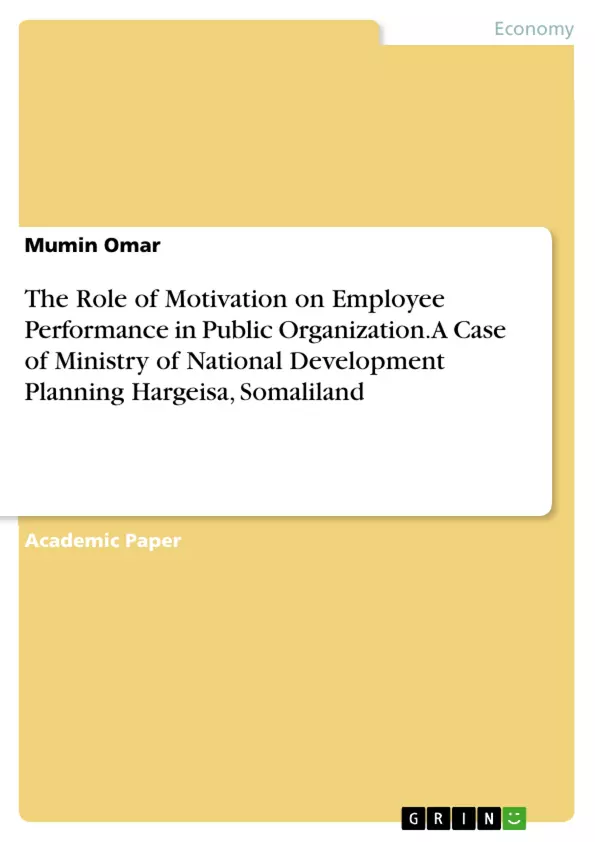The purpose of this study was to investigate the role of motivation on employee performance in public organization: a case of ministry of national development planning Hargeisa, Somaliland. This study guided by the following research questions. To determine the methods used by employers to motivate employees in the MoNDP, to know the extent that extrinsic motivation affects employees’ performance in the MoNDP, To examine how intrinsic motivation affect employees’ performance in the MoNDP, To identify how motivation link with employee work performance.
This study adopted a descriptive research design. The population of the study was 90 employees’ of the MoNDP. A census sampling was done and so the 90 employees constituted the sample size. A structured questionnaire was used to collect the data. The questionnaire was to administer by the researcher. The completed questionnaires were edited for completeness. The data were analyzed using the statistical package for social sciences (SPSS) computer package. The data were interpreted using descriptive statistics through frequencies, percentages and correlation analysis. The findings were presented in the form of tables and figures.
The study found out that the ministry uses many different tools to motivate its employees. These include; payments on time, employee rotation within the ministry and salary provision. However, the study also found out that NDP does not use provide fringe benefits to its employees. It was also found out that ministry doesn’t pay its workers according to the amount of work they have done also when employees meet targets ministry doesn’t provide bonuses the ministry does not carry out training of its employees. The study also found out that the organization does not make sure that that employee's work is challenging or involve them in decision making as a way of motivating them.
The research results indicated that there is a positive correlation between motivation and work performance. This means that changes in one variable are strongly correlated with changes in the second variable. Pearson’s r is .440**. This number is very close to one. For this reason, we can conclude that there is a strong relationship between motivation and employee performance variables
Inhaltsverzeichnis (Table of Contents)
- INTRODUCTION OF THE STUDY.
- Background of the Study.
- Statement of the Problem.
- Research Objectives.
- Research Questions.
- Scope.
- Significance of the Study.
- Organizational Profile.
- Operational Definitions of Key Terms.
- REVIEW OF RELATED LITERATURE
- Introduction.
- Concepts, Ideas, Opinions from Authors/Experts.
- Theoretical Review.
- Empirical Studies.
- METHODOLOGY
- Research Design.
- Research Population.
- Sample Size.
- Sampling Procedure.
- Research Instrument.
Zielsetzung und Themenschwerpunkte (Objectives and Key Themes)
This study aims to investigate the role of motivation on employee performance within a public organization, specifically the Ministry of National Development Planning in Hargeisa, Somaliland. The study explores the various motivational methods used by employers in the MoNDP, focusing on the impact of both extrinsic and intrinsic motivation on employee performance. The study also seeks to identify the relationship between motivation and employee work performance.
- Motivational methods employed by employers in the MoNDP
- Impact of extrinsic motivation on employee performance in the MoNDP
- Impact of intrinsic motivation on employee performance in the MoNDP
- Relationship between motivation and employee work performance
Zusammenfassung der Kapitel (Chapter Summaries)
The first chapter of the thesis provides a comprehensive introduction to the study, outlining the background, statement of the problem, research objectives and questions, scope, significance, organizational profile, and operational definitions of key terms.
Chapter two delves into a review of relevant literature. It examines concepts, ideas, and opinions from various authors and experts on motivation and employee performance. The chapter also presents a theoretical review and explores relevant empirical studies.
Chapter three outlines the methodology employed in the study, including the research design, population, sample size, sampling procedure, and research instrument used to collect data.
Schlüsselwörter (Keywords)
The main keywords and focus topics of the study include employee motivation, employee performance, public organizations, Somaliland, Ministry of National Development Planning, extrinsic motivation, intrinsic motivation, research methods, descriptive research, statistical analysis, correlation analysis.
- Citation du texte
- Mumin Omar (Auteur), 2017, The Role of Motivation on Employee Performance in Public Organization. A Case of Ministry of National Development Planning Hargeisa, Somaliland, Munich, GRIN Verlag, https://www.grin.com/document/471610



